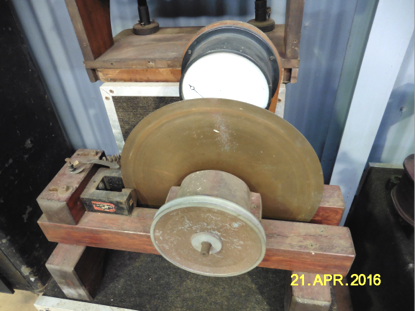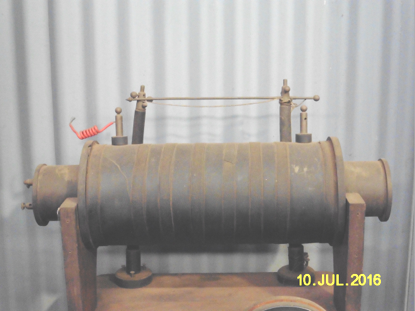
FARADAY DISK GENERATOR
A Replica by Rex Reading of Dalby
This replica is of Faraday’s and the world’s first electricity generator. It was with this machine that Faraday first demonstrated magneto-electric induction, the production of an electric current from mechanical energy.
The outer edge of the copper disk sits between the poles of the magnet to the left. When the copper disk rotates, a voltage is induced between the centre and the edge of the disk. In this replica, movement of the meter pointer indicates the effect, although the type of meter used here was not developed until the 1880s.
The brass strip, or ‘brush’, directly above the magnet, collects the electricity from the edge of the disc. Another brush near the centre of the disk makes the connection to complete the circuit.
Brushes are used in most generators and motors, to make the connection to the rotating part of the machine. In DC machines they rub on a cylindrical ‘commutator‘ that has a number of separate sections, each connected to a separate point on the generator’s rotating coils, or ‘armature‘.
Many AC machines do not have brushes. If they do, the switching action of a commutator is not required and each brush rubs on its own ‘slip ring’ connected to a separate point on the armature winding.
SPARK COIL, OR RUHMKORFF COIL
The coil is an induction coil, which is a form of transformer designed to produce high voltage sparks across the spark gap above the coil. This principle is used in cars to produce the sparks in the spark plugs. Ruhmkorff coils have been made that can produce sparks up to 1.2 metres long.
Heinrich Daniel Ruhmkorff developed the coil in the 1850s from designs of some earlier experimenters. It is another device operating on the principle of electro-magnetic induction.
Operation
Two separate coils are wound on to a magnetic iron core. One is a low voltage coil, the other a high voltage coil.
The low voltage coil has relatively few turns. It is connected to a DC source, typically a battery, by the two terminals at the left hand end of the machine.
The high voltage coil has very many turns. It is connected to the spark gap through the two terminals on the top of the machine As the electro-magnetic induction effect of a transformer requires a change of current for the effect, the current to the low voltage coil is rapidly switched on and off by an interrupting device in the battery circuit.
A capacitor, usually fitted in the base of the machine, increases the effectiveness of the machine.
The induction coil has been used for a number of purposes. Early radio transmitters, called spark transmitters, used this device to produce the broadcast signal.



WOOLRICH ELECTROMAGNETIC GENERATOR
A replica made by Rex Redding of Dalby
A replica of possibly one of the earliest generators made for commercial purposes. John Stephen Woolrich, a chemist, made the original machine in 1844 to generate electricity for electroplating. In 1842, he had patented the idea for this purpose.
Electroplating with Woolrich’s generator was the first commercial use of generated electricity. Generators of the type as Woolrich’s are often called magnetos, as permanent magnets are used to create the magnetic field in which the windings rotate.
In contrast, most generators use electromagnets in which a current flows through a coil to create the magnet field. Electromagnets can produce stronger fields, and importantly, the field can be varied to adjust the voltage generated.
Electroplating requires a direct current, so the generator is fitted with an early commutator.
